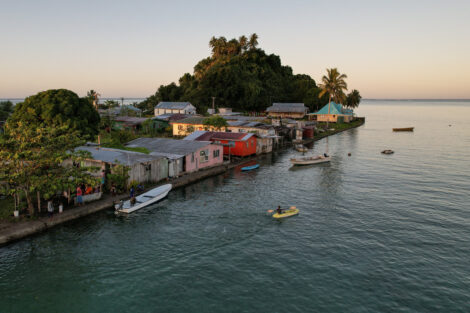Pacific island sea levels rising faster than global average, WMO says

FILE PHOTO: The morning’s first rays of sunlight hit the island community of Serua Village, Fiji, July 15, 2022. As the community runs out of ways to adapt to the rising Pacific Ocean, the 80 villagers face the painful decision whether to move. REUTERS/Loren Elliott/File Photo
GENEVA — Sea levels in the South-West Pacific are rising faster than the global average, threatening low-lying islands while heat damages marine ecosystems, the United Nations meteorological agency said Friday.
In its State of the Climate in the South-West Pacific 2022 report, the World Meteorological Organization (WMO) said water levels were rising about 4 mm per year in some areas, slightly above the global mean rate.
That means low-lying territories such as Tuvalu and the Solomon Islands over time could become flooded, destroying agricultural and habitable lands with inhabitants unable to move to higher elevations.
The report added that marine heatwaves had occurred in a large area northeast of Australia and south of Papua New Guinea over more than six months, affecting marine life and the livelihoods of local communities.
READ: World ocean surface temperature reaches new record high
WMO Secretary-General Petteri Taalas said that El Niño, a warming of water surface temperatures in the eastern and central Pacific Ocean that returned this year, would strongly affect the region.
“This will have a big impact on the South-West Pacific region as it is frequently associated with higher temperatures, disruptive weather patterns and more marine heatwaves and coral bleaching,” Taalas said in a statement.
Last year, the region recorded 35 natural hazards, including floods and storms, that killed more than 700 people, according to the report. These hazards directly affected more than 8 million people.
Although the number of reported disaster weather events in the region decreased last year compared to 2021, the scale of economic losses due to flooding and weather events increased, according to the report.
Flood damage, including in Australia and the Philippines, amounted to $8.5 billion, almost triple the previous year.
RELATED STORIES
PH sea level rising 3 times faster than world average, says expert
Climate crisis to turn Manila, other Asian cities into bodies of water